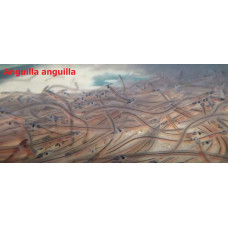The river eels (Anguillidae) are a family of the order Eels (Anguilliformes). 1 genus, 20 species and subspecies. The body is eel-shaped, covered with fine scales. The pelvic fins are absent. Dorsal and anal fins are long and merge with the caudal fin. Widespread in the Atlantic, Pacific and Indian Oceans.
The river eel (Anguilla anguilla) belongs to the family. A marine catadromous species. Body length up to 2 m. Passable fish. Spawning in the Sargasso Sea at great depths. After spawning die. Development of the larva with transformation. In fresh water spend 4-6 years, sometimes up to 10 years. Feed on crustaceans, mollusks, frogs, eggs and small fish. In the sea do not feed, intestines degenerate. Known in the lower reaches of the Pechora, the Volga system, the Northern Dvina, Lake Peipsi, Lakes Onega and Ladoga, and some lakes of Karelia. Rare in the White Sea, Don and Kuban. Numerous in rivers of the Baltic Sea coast. Valuable commercial fish.
A very close subspecies, characterized by a smaller number of vertebrae, lives in the rivers of the Atlantic coast of the Americas from Guiana and Panama in the south to Greenland in the north.
The third subspecies, the Japanese eel, is more multi-spined, with a dark border on the fins, and inhabits the rivers of Japan and the Pacific coast of Asia from Liaohe to Canton.
The eel sometimes reaches 2 m in length, more often 50-150 cm (weighing up to 4-6 kg). Its scales are small, inconspicuous, usually without a silvery glow, the back is dark green or brown, the sides are yellow, and the belly is yellowish or white. The coloration of the eel is variable and depends on the age of the fish and the nature of the water body. The skin is slimy and slippery: a live eel is very difficult to hold in your hands. There are two forms of eels - sharp-headed and broad-headed. Sharp-headed eel is more valuable - its fat content reaches 27, 5%, while the wide-headed eel only up to 12-19%. At present, it is believed that both forms are only extreme variants. Getting into places abundant in small food organisms, the eel grows narrow-headed, with a sharp face and a small mouth. If it has to predate, it develops a broad head with a blunt muzzle and a large mouth, which allows it to capture large animals - fish and crayfish up to 15 cm long.
Usually immature eels inhabit rivers, but often enter lakes and ponds. In fresh water, the eel has a sharply expressed negative rheotaxis: it always tends to go against the current, rising to the very headwaters of rivers. When settling, eels often use the smallest streams and even enter water pipes. We have observed cases when eels crawled from one water body to another on wet grass. In humid air without water eel at 24 ° C survives up to 36 hours, as its mucous skin can consume oxygen more than 17 cm3 per hour per kilogram of weight. However, the stories that eels crawl out at night into the fields to eat peas and, when released on the ground, choose the shortest distance to the nearest water are not true.
The eel is strictly nocturnal. It spends all daylight hours in a shelter, most often burrowing into muddy soil, penetrating up to 80 cm, and according to some data, up to 1.5 m. At night, especially when it is cloudy and moonless, eels go hunting. Small individuals feed on aquatic insect larvae, mollusks, worms and crustaceans. Fish, mainly small and non-target fish (perch, ruff, roach) play an important role in the diet of large ones. Therefore, eels are caught in traps and bottom rods mainly at night. Sometimes, however, the eel is caught on a trolley and daytime: sitting in his hole, sticking his head out of it, he does not miss the opportunity to grab everything that he considers edible. Despite the exceptional voracity, the eel grows relatively slowly, but in very good conditions observed gains of up to 500 g per year. The fattening season lasts throughout the warm season, from April to November. Eels do not feed in winter. They spend the cold season in a state of hibernation, burrowing deep into the mud. Males are usually much smaller than females.
Eels roll into the sea at night, preferring the darkest, moonless nights. They breed in the sea. But it has not been established where their spawning grounds are located or what the larva looks like.
River eels
Tags: river eels



